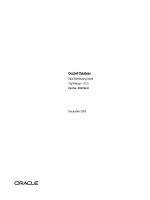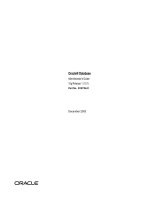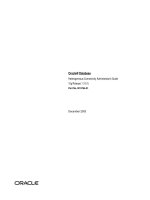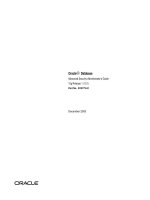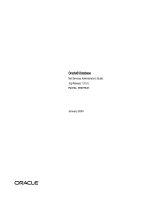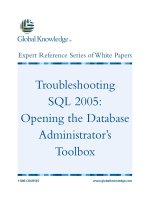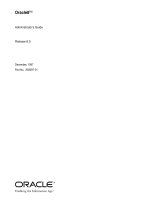Oracle Database Administrator''''s Guide
Bạn đang xem bản rút gọn của tài liệu. Xem và tải ngay bản đầy đủ của tài liệu tại đây (11.43 MB, 1,078 trang )
Oracle® Database
Administrator's Guide
10g Release 1 (10.1)
Part No. B10739-01
December 2003
Oracle Database Administrator’s Guide, 10g Release 1 (10.1)
Part No. B10739-01
Copyright © 2001, 2003 Oracle. All rights reserved.
Primary Author: Ruth Baylis
Contributing Authors: Paul Lane, Diana Lorentz
Contributors: David Austin, Mark Bauer, Eric Belden, Allen Brumm, Mark Dilman, Harvey Eneman,
Amit Ganesh, Carolyn Gray, Joan Gregoire, Daniela Hansell, Wei Huang, Robert Jenkins, Sushil Kumar,
Bill Lee, Yunrui Li, Rich Long, Catherine Luu, Mughees Minhas, Valarie Moore, Sujatha Muthulingam,
Gary Ngai, Waleed Ojeil, Rod Payne, Ananth Raghavan, Ann Rhee, Jags Srinivasan, Anh-Tuan Tran,
Vikarm Shukla, Deborah Steiner, Janet Stern, Michael Stewart, Alex Tsukerman, Kothanda
Umamageswaran, Daniel Wong, Wanli Yang
The Programs (which include both the software and documentation) contain proprietary information;
they are provided under a license agreement containing restrictions on use and disclosure and are also
protected by copyright, patent, and other intellectual and industrial property laws. Reverse engineering,
disassembly, or decompilation of the Programs, except to the extent required to obtain interoperability
with other independently created software or as specified by law, is prohibited.
The information contained in this document is subject to change without notice. If you find any problems
in the documentation, please report them to us in writing. This document is not warranted to be
error-free. Except as may be expressly permitted in your license agreement for these Programs, no part of
these Programs may be reproduced or transmitted in any form or by any means, electronic or
mechanical, for any purpose.
If the Programs are delivered to the United States Government or anyone licensing or using the
Programs on behalf of the United States Government, the following notice is applicable:
U.S. GOVERNMENT RIGHTS Programs, software, databases, and related documentation and technical
data delivered to U.S. Government customers are "commercial computer software" or "commercial
technical data" pursuant to the applicable Federal Acquisition Regulation and agency-specific
supplemental regulations. As such, use, duplication, disclosure, modification, and adaptation of the
Programs, including documentation and technical data, shall be subject to the licensing restrictions set
forth in the applicable Oracle license agreement, and, to the extent applicable, the additional rights set
forth in FAR 52.227-19, Commercial Computer Software--Restricted Rights (June 1987). Oracle
Corporation, 500 Oracle Parkway, Redwood City, CA 94065
The Programs are not intended for use in any nuclear, aviation, mass transit, medical, or other inherently
dangerous applications. It shall be the licensee's responsibility to take all appropriate fail-safe, backup,
redundancy and other measures to ensure the safe use of such applications if the Programs are used for
such purposes, and we disclaim liability for any damages caused by such use of the Programs.
Oracle is a registered trademark of Oracle Corporation and/or its affiliates. Other names may be
trademarks of their respective owners.
The Programs may provide links to Web sites and access to content, products, and services from third
parties. Oracle is not responsible for the availability of, or any content provided on, third-party Web sites.
You bear all risks associated with the use of such content. If you choose to purchase any products or
services from a third party, the relationship is directly between you and the third party. Oracle is not
responsible for: (a) the quality of third-party products or services; or (b) fulfilling any of the terms of the
agreement with the third party, including delivery of products or services and warranty obligations
related to purchased products or services. Oracle is not responsible for any loss or damage of any sort
that you may incur from dealing with any third party.
iii
Contents
Send Us Your Comments
.............................................................................................................. xxxi
Preface
...................................................................................................................................................... xxxiii
Audience ........................................................................................................................................... xxxiv
Organization..................................................................................................................................... xxxiv
Related Documentation ................................................................................................................ xxxviii
Conventions...................................................................................................................................... xxxix
Documentation Accessibility ............................................................................................................ xliv
What's New in the Oracle Database 10g Administrator's Guide?
......................... xlvii
Oracle Database 10g Release 1 (10.1) New Features..................................................................... xlvii
Volume 1
Part I Basic Database Administration
1 Overview of Administering an Oracle Database
Types of Oracle Database Users....................................................................................................... 1-1
Database Administrators............................................................................................................. 1-2
Security Officers............................................................................................................................ 1-3
Network Administrators ............................................................................................................. 1-3
Application Developers............................................................................................................... 1-3
Application Administrators........................................................................................................ 1-4
Database Users.............................................................................................................................. 1-4
iv
Tasks of a Database Administrator.................................................................................................. 1-4
Task 1: Evaluate the Database Server Hardware ..................................................................... 1-5
Task 2: Install the Oracle Database Software............................................................................ 1-5
Task 3: Plan the Database ............................................................................................................ 1-5
Task 4: Create and Open the Database...................................................................................... 1-6
Task 5: Back Up the Database ..................................................................................................... 1-7
Task 6: Enroll System Users ........................................................................................................ 1-7
Task 7: Implement the Database Design ................................................................................... 1-7
Task 8: Back Up the Fully Functional Database ....................................................................... 1-7
Task 9: Tune Database Performance.......................................................................................... 1-7
Identifying Your Oracle Database Software Release................................................................... 1-8
Release Number Format .............................................................................................................. 1-8
Checking Your Current Release Number ................................................................................. 1-9
Database Administrator Security and Privileges ....................................................................... 1-10
The Database Administrator's Operating System Account.................................................. 1-10
Database Administrator Usernames........................................................................................ 1-10
Database Administrator Authentication...................................................................................... 1-12
Administrative Privileges.......................................................................................................... 1-12
Selecting an Authentication Method ....................................................................................... 1-15
Using Operating System Authentication ................................................................................ 1-17
Using Password File Authentication ....................................................................................... 1-18
Creating and Maintaining a Password File.................................................................................. 1-20
Using ORAPWD ......................................................................................................................... 1-20
Setting REMOTE_LOGIN_ PASSWORDFILE........................................................................ 1-22
Adding Users to a Password File ............................................................................................. 1-22
Maintaining a Password File..................................................................................................... 1-24
Server Manageability....................................................................................................................... 1-26
Automatic Manageability Features.......................................................................................... 1-26
Data Utilities................................................................................................................................ 1-28
2 Creating an Oracle Database
Deciding How to Create an Oracle Database................................................................................ 2-2
Manually Creating an Oracle Database.......................................................................................... 2-2
Considerations Before Creating the Database.......................................................................... 2-3
Creating the Database .................................................................................................................. 2-5
Understanding the CREATE DATABASE Statement................................................................. 2-14
v
Protecting Your Database: Specifying Passwords for Users SYS and SYSTEM................ 2-15
Creating a Locally Managed SYSTEM Tablespace................................................................ 2-15
Creating the SYSAUX Tablespace............................................................................................ 2-17
Using Automatic Undo Management: Creating an Undo Tablespace ............................... 2-19
Creating a Default Permanent Tablespace.............................................................................. 2-20
Creating a Default Temporary Tablespace ............................................................................. 2-20
Specifying Oracle-Managed Files at Database Creation....................................................... 2-21
Supporting Bigfile Tablespaces During Database Creation................................................. 2-23
Specifying the Database Time Zone and Time Zone File ..................................................... 2-25
Specifying FORCE LOGGING Mode ...................................................................................... 2-26
Initialization Parameters and Database Creation....................................................................... 2-27
Determining the Global Database Name ................................................................................ 2-28
Specifying a Flash Recovery Area............................................................................................ 2-29
Specifying Control Files ............................................................................................................ 2-30
Specifying Database Block Sizes............................................................................................... 2-31
Managing the System Global Area (SGA) ............................................................................. 2-32
Specifying the Maximum Number of Processes.................................................................... 2-42
Specifying the Method of Undo Space Management............................................................ 2-42
The COMPATIBLE Initialization Parameter and Irreversible Compatibility ................... 2-43
Setting the License Parameter................................................................................................... 2-44
Troubleshooting Database Creation ............................................................................................. 2-44
Dropping a Database ....................................................................................................................... 2-45
Managing Initialization Parameters Using a Server Parameter File ...................................... 2-45
What Is a Server Parameter File?.............................................................................................. 2-46
Migrating to a Server Parameter File....................................................................................... 2-46
Creating a Server Parameter File.............................................................................................. 2-47
The SPFILE Initialization Parameter........................................................................................ 2-49
Using ALTER SYSTEM to Change Initialization Parameter Values................................... 2-49
Exporting the Server Parameter File........................................................................................ 2-51
Backing Up the Server Parameter File..................................................................................... 2-52
Errors and Recovery for the Server Parameter File............................................................... 2-52
Viewing Parameter Settings...................................................................................................... 2-53
Defining Application Services for Oracle Database 10g .......................................................... 2-53
Deploying Services .................................................................................................................... 2-54
Configuring Services ................................................................................................................. 2-55
vi
Using Services ............................................................................................................................ 2-56
Considerations After Creating a Database................................................................................... 2-57
Some Security Considerations .................................................................................................. 2-57
Installing the Oracle Database Sample Schemas.................................................................... 2-60
Viewing Information About the Database................................................................................... 2-60
3 Starting Up and Shutting Down
Starting Up a Database ...................................................................................................................... 3-1
Options for Starting Up a Database ........................................................................................... 3-2
Preparing to Start an Instance..................................................................................................... 3-3
Using SQL*Plus to Start Up a Database .................................................................................... 3-3
Starting an Instance: Scenarios.................................................................................................... 3-5
Altering Database Availability......................................................................................................... 3-9
Mounting a Database to an Instance.......................................................................................... 3-9
Opening a Closed Database ........................................................................................................ 3-9
Opening a Database in Read-Only Mode................................................................................ 3-10
Restricting Access to an Open Database ................................................................................. 3-10
Shutting Down a Database ............................................................................................................. 3-11
Shutting Down with the NORMAL Clause............................................................................ 3-11
Shutting Down with the IMMEDIATE Clause....................................................................... 3-12
Shutting Down with the TRANSACTIONAL Clause........................................................... 3-12
Shutting Down with the ABORT Clause................................................................................. 3-13
Quiescing a Database....................................................................................................................... 3-14
Placing a Database into a Quiesced State................................................................................ 3-15
Restoring the System to Normal Operation............................................................................ 3-16
Viewing the Quiesce State of an Instance................................................................................ 3-16
Suspending and Resuming a Database........................................................................................ 3-16
4 Managing Oracle Database Processes
About Dedicated and Shared Server Processes ............................................................................ 4-1
Dedicated Server Processes......................................................................................................... 4-2
Shared Server Processes............................................................................................................... 4-3
Configuring Oracle Database for Shared Server .......................................................................... 4-5
Initialization Parameters for Shared Server.............................................................................. 4-6
Enabling Shared Server................................................................................................................ 4-6
Configuring Dispatchers.............................................................................................................. 4-9
vii
Monitoring Shared Server ......................................................................................................... 4-16
About Oracle Database Background Processes .......................................................................... 4-17
Managing Processes for Parallel SQL Execution........................................................................ 4-19
About Parallel Execution Servers............................................................................................. 4-20
Altering Parallel Execution for a Session ................................................................................ 4-21
Managing Processes for External Procedures.............................................................................. 4-22
Terminating Sessions....................................................................................................................... 4-23
Identifying Which Session to Terminate................................................................................. 4-23
Terminating an Active Session ................................................................................................. 4-24
Terminating an Inactive Session............................................................................................... 4-24
Monitoring the Operation of Your Database .............................................................................. 4-25
Server-Generated Alerts ............................................................................................................ 4-25
Monitoring the Database Using Trace Files and the Alert File............................................ 4-29
Monitoring Locks........................................................................................................................ 4-32
Monitoring Wait Events ............................................................................................................ 4-33
Process and Session Views ....................................................................................................... 4-33
Part II Oracle Database Structure and Storage
5 Managing Control Files
What Is a Control File?....................................................................................................................... 5-1
Guidelines for Control Files............................................................................................................. 5-2
Provide Filenames for the Control Files.................................................................................... 5-2
Multiplex Control Files on Different Disks............................................................................... 5-3
Back Up Control Files .................................................................................................................. 5-3
Manage the Size of Control Files................................................................................................ 5-4
Creating Control Files........................................................................................................................ 5-4
Creating Initial Control Files....................................................................................................... 5-4
Creating Additional Copies, Renaming, and Relocating Control Files ............................... 5-5
Creating New Control Files ........................................................................................................ 5-5
Troubleshooting After Creating Control Files.............................................................................. 5-9
Checking for Missing or Extra Files........................................................................................... 5-9
Handling Errors During CREATE CONTROLFILE.............................................................. 5-10
Backing Up Control Files ................................................................................................................ 5-10
Recovering a Control File Using a Current Copy....................................................................... 5-10
viii
Recovering from Control File Corruption Using a Control File Copy ............................... 5-10
Recovering from Permanent Media Failure Using a Control File Copy ............................ 5-11
Dropping Control Files.................................................................................................................... 5-11
Displaying Control File Information............................................................................................ 5-12
6 Managing the Redo Log
What Is the Redo Log? ....................................................................................................................... 6-1
Redo Threads................................................................................................................................. 6-2
Redo Log Contents ....................................................................................................................... 6-2
How Oracle Database Writes to the Redo Log......................................................................... 6-3
Planning the Redo Log....................................................................................................................... 6-5
Multiplexing Redo Log Files....................................................................................................... 6-5
Placing Redo Log Members on Different Disks ....................................................................... 6-9
Setting the Size of Redo Log Members...................................................................................... 6-9
Choosing the Number of Redo Log Files .................................................................................. 6-9
Controlling Archive Lag ........................................................................................................... 6-10
Creating Redo Log Groups and Members ................................................................................... 6-12
Creating Redo Log Groups........................................................................................................ 6-12
Creating Redo Log Members .................................................................................................... 6-13
Relocating and Renaming Redo Log Members ......................................................................... 6-14
Dropping Redo Log Groups and Members................................................................................. 6-15
Dropping Log Groups................................................................................................................ 6-16
Dropping Redo Log Members .................................................................................................. 6-17
Forcing Log Switches ....................................................................................................................... 6-18
Verifying Blocks in Redo Log Files............................................................................................... 6-18
Clearing a Redo Log File ................................................................................................................. 6-19
Viewing Redo Log Information .................................................................................................... 6-20
7 Managing Archived Redo Logs
What Is the Archived Redo Log?...................................................................................................... 7-1
Choosing Between NOARCHIVELOG and ARCHIVELOG Mode......................................... 7-2
Running a Database in NOARCHIVELOG Mode................................................................... 7-3
Running a Database in ARCHIVELOG Mode.......................................................................... 7-3
Controlling Archiving........................................................................................................................ 7-5
Setting the Initial Database Archiving Mode ........................................................................... 7-5
Changing the Database Archiving Mode ................................................................................. 7-5
ix
Performing Manual Archiving ................................................................................................... 7-6
Adjusting the Number of Archiver Processes.......................................................................... 7-7
Specifying the Archive Destination................................................................................................ 7-7
Specifying Archive Destinations ................................................................................................ 7-8
Understanding Archive Destination Status............................................................................ 7-11
Specifying the Mode of Log Transmission.................................................................................. 7-12
Normal Transmission Mode ..................................................................................................... 7-12
Standby Transmission Mode ................................................................................................... 7-13
Managing Archive Destination Failure........................................................................................ 7-14
Specifying the Minimum Number of Successful Destinations............................................ 7-14
Rearchiving to a Failed Destination......................................................................................... 7-17
Controlling Trace Output Generated by the Archivelog Process............................................ 7-18
Viewing Information About the Archived Redo Log................................................................ 7-19
Dynamic Performance Views ................................................................................................... 7-19
The ARCHIVE LOG LIST Command...................................................................................... 7-20
8 Managing Tablespaces
Guidelines for Managing Tablespaces........................................................................................... 8-2
Using Multiple Tablespaces........................................................................................................ 8-2
Assigning Tablespace Quotas to Users ..................................................................................... 8-3
Creating Tablespaces.......................................................................................................................... 8-3
Locally Managed Tablespaces .................................................................................................... 8-4
Bigfile Tablespaces ....................................................................................................................... 8-9
Dictionary-Managed Tablespaces............................................................................................ 8-11
Temporary Tablespaces............................................................................................................. 8-17
Multiple Temporary Tablespaces: Using Tablespace Groups ............................................. 8-21
Specifying Nonstandard Block Sizes for Tablespaces .............................................................. 8-23
Controlling the Writing of Redo Records .................................................................................... 8-24
Altering Tablespace Availability .................................................................................................. 8-25
Taking Tablespaces Offline ....................................................................................................... 8-25
Bringing Tablespaces Online .................................................................................................... 8-27
Using Read-Only Tablespaces........................................................................................................ 8-27
Making a Tablespace Read-Only.............................................................................................. 8-28
Making a Read-Only Tablespace Writable ............................................................................ 8-30
Creating a Read-Only Tablespace on a WORM Device........................................................ 8-31
Delaying the Opening of Datafiles in Read-Only Tablespaces............................................ 8-31
x
Renaming Tablespaces..................................................................................................................... 8-32
Dropping Tablespaces ..................................................................................................................... 8-33
Managing the SYSAUX Tablespace............................................................................................... 8-34
Monitoring Occupants of the SYSAUX Tablespace............................................................... 8-35
Moving Occupants Out Of or Into the SYSAUX Tablespace ............................................... 8-35
Controlling the Size of the SYSAUX Tablespace.................................................................... 8-36
Diagnosing and Repairing Locally Managed Tablespace Problems ...................................... 8-36
Scenario 1: Fixing Bitmap When Allocated Blocks are Marked Free (No Overlap) ......... 8-38
Scenario 2: Dropping a Corrupted Segment........................................................................... 8-38
Scenario 3: Fixing Bitmap Where Overlap is Reported......................................................... 8-38
Scenario 4: Correcting Media Corruption of Bitmap Blocks ................................................ 8-39
Scenario 5: Migrating from a Dictionary-Managed to a Locally Managed Tablespace ... 8-39
Migrating the SYSTEM Tablespace to a Locally Managed Tablespace.................................. 8-40
Transporting Tablespaces Between Databases............................................................................ 8-40
Introduction to Transportable Tablespaces ............................................................................ 8-41
About Transporting Tablespaces Across Platforms .............................................................. 8-42
Limitations on Transportable Tablespace Use ....................................................................... 8-43
Compatibility Considerations for Transportable Tablespaces............................................. 8-44
Transporting Tablespaces Between Databases: A Procedure and Example ...................... 8-45
Using Transportable Tablespaces: Scenarios.......................................................................... 8-54
Moving Databases Across Platforms Using Transportable Tablespaces............................ 8-58
Viewing Tablespace Information................................................................................................... 8-59
Example 1: Listing Tablespaces and Default Storage Parameters....................................... 8-60
Example 2: Listing the Datafiles and Associated Tablespaces of a Database .................... 8-60
Example 3: Displaying Statistics for Free Space (Extents) of Each Tablespace.................. 8-61
9 Managing Datafiles and Tempfiles
Guidelines for Managing Datafiles................................................................................................. 9-1
Determine the Number of Datafiles........................................................................................... 9-2
Determine the Size of Datafiles................................................................................................... 9-4
Place Datafiles Appropriately..................................................................................................... 9-5
Store Datafiles Separate from Redo Log Files .......................................................................... 9-5
Creating Datafiles and Adding Datafiles to a Tablespace .......................................................... 9-5
Changing Datafile Size ...................................................................................................................... 9-6
Enabling and Disabling Automatic Extension for a Datafile ................................................. 9-7
Manually Resizing a Datafile ...................................................................................................... 9-8
xi
Altering Datafile Availability........................................................................................................... 9-8
Bringing Datafiles Online or Taking Offline in ARCHIVELOG Mode ................................ 9-9
Taking Datafiles Offline in NOARCHIVELOG Mode .......................................................... 9-10
Altering the Availability of All Datafiles or Tempfiles in a Tablespace............................. 9-10
Renaming and Relocating Datafiles.............................................................................................. 9-11
Procedures for Renaming and Relocating Datafiles in a Single Tablespace...................... 9-11
Procedure for Renaming and Relocating Datafiles in Multiple Tablespaces .................... 9-14
Dropping Datafiles ........................................................................................................................... 9-15
Verifying Data Blocks in Datafiles ................................................................................................ 9-15
Copying Files Using the Database Server.................................................................................... 9-15
Copying a File on a Local File System..................................................................................... 9-16
Third-Party File Transfer........................................................................................................... 9-17
File Transfer and the DBMS_SCHEDULER Package............................................................ 9-18
Advanced File Transfer Mechanisms ...................................................................................... 9-19
Mapping Files to Physical Devices ............................................................................................... 9-19
Overview of Oracle Database File Mapping Interface.......................................................... 9-20
How the Oracle Database File Mapping Interface Works.................................................... 9-20
Using the Oracle Database File Mapping Interface............................................................... 9-25
File Mapping Examples ............................................................................................................. 9-29
Viewing Datafile Information .................................................................................................. 9-32
10 Managing the Undo Tablespace
What Is Undo? ................................................................................................................................... 10-1
Introduction to Automatic Undo Management ......................................................................... 10-2
Overview of Automatic Undo Management.......................................................................... 10-2
Undo Retention........................................................................................................................... 10-4
Retention Guarantee .................................................................................................................. 10-5
Sizing the Undo Tablespace............................................................................................................ 10-6
Using Auto-Extensible Tablespaces......................................................................................... 10-6
Sizing Fixed-Size Undo Tablespaces ....................................................................................... 10-7
Managing Undo Tablespaces.......................................................................................................... 10-8
Creating an Undo Tablespace................................................................................................... 10-9
Altering an Undo Tablespace ................................................................................................. 10-10
Dropping an Undo Tablespace............................................................................................... 10-11
Switching Undo Tablespaces.................................................................................................. 10-11
Establishing User Quotas for Undo Space............................................................................ 10-12
xii
Monitoring the Undo Tablespace ................................................................................................ 10-13
Flashback Features and Undo Space........................................................................................... 10-15
Flashback Query ....................................................................................................................... 10-15
Flashback Versions Query....................................................................................................... 10-16
Flashback Transaction Query ................................................................................................. 10-16
Flashback Table......................................................................................................................... 10-17
Migration to Automatic Undo Management ............................................................................. 10-17
Best Practices.................................................................................................................................... 10-17
Part III Automated File and Storage Management
11 Using Oracle-Managed Files
What Are Oracle-Managed Files? .................................................................................................. 11-1
Who Can Use Oracle-Managed Files? ..................................................................................... 11-2
Benefits of Using Oracle-Managed Files ................................................................................. 11-3
Oracle-Managed Files and Existing Functionality................................................................. 11-4
Enabling the Creation and Use of Oracle-Managed Files......................................................... 11-4
Setting the DB_CREATE_FILE_DEST Initialization Parameter........................................... 11-5
Setting the DB_RECOVERY_FILE_DEST Parameter ............................................................ 11-6
Setting the DB_CREATE_ONLINE_LOG_DEST_n Initialization Parameter.................... 11-6
Creating Oracle-Managed Files...................................................................................................... 11-7
How Oracle-Managed Files Are Named................................................................................. 11-8
Creating Oracle-Managed Files at Database Creation .......................................................... 11-9
Creating Datafiles for Tablespaces Using Oracle-Managed Files...................................... 11-15
Creating Tempfiles for Temporary Tablespaces Using Oracle-Managed Files............... 11-18
Creating Control Files Using Oracle-Managed Files........................................................... 11-19
Creating Redo Log Files Using Oracle-Managed Files ....................................................... 11-21
Creating Archived Logs Using Oracle-Managed Files........................................................ 11-22
Behavior of Oracle-Managed Files .............................................................................................. 11-23
Dropping Datafiles and Tempfiles......................................................................................... 11-23
Dropping Redo Log Files......................................................................................................... 11-24
Renaming Files.......................................................................................................................... 11-24
Managing Standby Databases ................................................................................................ 11-24
Scenarios for Using Oracle-Managed Files................................................................................ 11-24
Scenario 1: Create and Manage a Database with Multiplexed Redo Logs....................... 11-25
xiii
Scenario 2: Create and Manage a Database with Database Area and Flash Recovery Area......
11-29
Scenario 3: Adding Oracle-Managed Files to an Existing Database ................................. 11-31
12 Using Automatic Storage Management
What Is Automatic Storage Management?................................................................................... 12-1
Overview of the Components of Automatic Storage Management........................................ 12-2
Administering an ASM Instance ................................................................................................... 12-3
Installation of ASM..................................................................................................................... 12-4
Authentication for Accessing an ASM Instance..................................................................... 12-4
Setting Initialization Parameters for an ASM Instance ......................................................... 12-5
Starting Up an ASM Instance.................................................................................................... 12-7
Shutting Down an ASM Instance........................................................................................... 12-10
Disk Group Fixed Tables......................................................................................................... 12-10
Configuring the Components of Automatic Storage Management ...................................... 12-10
Considerations and Guidelines for Configuring an ASM Instance .................................. 12-11
Creating a Disk Group............................................................................................................. 12-13
Altering the Disk Membership of a Disk Group.................................................................. 12-15
Mounting and Dismounting Disk Groups............................................................................ 12-20
Managing Disk Group Templates.......................................................................................... 12-21
Managing Disk Group Directories ........................................................................................ 12-23
Managing Alias Names for ASM Filenames ........................................................................ 12-25
Dropping Files and Associated Aliases from a Disk Group .............................................. 12-26
Checking Internal Consistency of Disk Group Metadata .................................................. 12-27
Dropping Disk Groups ............................................................................................................ 12-27
Using Automatic Storage Management in the Database ........................................................ 12-28
What Types of Files Does Automatic Storage Management Support?............................. 12-29
About ASM Filenames............................................................................................................. 12-30
Starting the ASM and Database Instances ............................................................................ 12-34
Creating and Referencing ASM Files in the Database ........................................................ 12-36
Creating a Database Using Automatic Storage Management............................................ 12-38
Creating Tablespaces Using Automatic Storage Management.......................................... 12-39
Creating Redo Logs Using Automatic Storage Management............................................ 12-41
Creating a Control File Using Automatic Storage Management....................................... 12-41
Creating Archive Log Files Using Automatic Storage Management................................ 12-43
Recovery Manager (RMAN) and Automatic Storage Management................................. 12-43
xiv
Viewing Information About Automatic Storage Management ............................................. 12-44
Volume 2
Part IV Schema Objects
13 Managing Space for Schema Objects
Managing Space in Data Blocks..................................................................................................... 13-1
Specifying the PCTFREE Parameter ........................................................................................ 13-2
Specifying the PCTUSED Parameter ....................................................................................... 13-5
Selecting Associated PCTUSED and PCTFREE Values ........................................................ 13-7
Specifying the INITRANS Parameter ...................................................................................... 13-7
Managing Space in Tablespaces .................................................................................................... 13-9
Managing Storage Parameters...................................................................................................... 13-10
Identifying the Storage Parameters........................................................................................ 13-11
Setting Default Storage Parameters for Objects Created in a Tablespace ........................ 13-13
Specifying Storage Parameters at Object Creation............................................................... 13-13
Setting Storage Parameters for Clusters................................................................................ 13-14
Setting Storage Parameters for Partitioned Tables .............................................................. 13-14
Setting Storage Parameters for Index Segments................................................................... 13-14
Setting Storage Parameters for LOBs, Varrays, and Nested Tables .................................. 13-14
Changing Values of Storage Parameters............................................................................... 13-15
Understanding Precedence in Storage Parameters.............................................................. 13-15
Example of How Storage Parameters Effect Space Allocation .......................................... 13-16
Managing Resumable Space Allocation..................................................................................... 13-17
Resumable Space Allocation Overview................................................................................. 13-17
Enabling and Disabling Resumable Space Allocation......................................................... 13-21
Using a LOGON Trigger to Set Default Resumable Mode................................................. 13-23
Detecting Suspended Statements ........................................................................................... 13-24
Operation-Suspended Alert .................................................................................................... 13-26
Resumable Space Allocation Example: Registering an AFTER SUSPEND Trigger........ 13-26
Reclaiming Unused Space............................................................................................................. 13-28
Segment Advisor....................................................................................................................... 13-29
Shrinking Database Segments ................................................................................................ 13-32
Deallocating Unused Space..................................................................................................... 13-34
xv
Understanding Space Usage of Datatypes................................................................................. 13-34
Displaying Information About Space Usage for Schema Objects........................................ 13-35
Using PL/SQL Packages to Display Information About Schema Object Space Usage.. 13-35
Using Views to Display Information About Space Usage in Schema Objects................. 13-36
Capacity Planning for Database Objects .................................................................................. 13-40
Estimating the Space Use of a Table ..................................................................................... 13-40
Estimating the Space Use of an Index ................................................................................... 13-41
Obtaining Object Growth Trends .......................................................................................... 13-41
14 Managing Tables
About Tables...................................................................................................................................... 14-1
Guidelines for Managing Tables ................................................................................................... 14-2
Design Tables Before Creating Them ...................................................................................... 14-3
Consider Your Options for the Type of Table to Create....................................................... 14-3
Specify How Data Block Space Is to Be Used......................................................................... 14-4
Specify the Location of Each Table .......................................................................................... 14-5
Consider Parallelizing Table Creation..................................................................................... 14-6
Consider Using NOLOGGING When Creating Tables ....................................................... 14-6
Consider Using Table Compression when Creating Tables ................................................ 14-6
Estimate Table Size and Plan Accordingly ............................................................................. 14-7
Restrictions to Consider When Creating Tables .................................................................... 14-7
Creating Tables.................................................................................................................................. 14-8
Creating a Table.......................................................................................................................... 14-8
Creating a Temporary Table ..................................................................................................... 14-9
Parallelizing Table Creation.................................................................................................... 14-10
Inserting Data Into Tables Using Direct-Path INSERT........................................................... 14-11
Advantages of Using Direct-Path INSERT ........................................................................... 14-13
Enabling Direct-Path INSERT................................................................................................. 14-14
How Direct-Path INSERT Works........................................................................................... 14-14
Specifying the Logging Mode for Direct-Path INSERT ...................................................... 14-15
Additional Considerations for Direct-Path INSERT ........................................................... 14-16
Automatically Collecting Statistics on Tables........................................................................... 14-17
Altering Tables ................................................................................................................................ 14-18
Reasons for Using the ALTER TABLE Statement................................................................ 14-19
Altering Physical Attributes of a Table ................................................................................. 14-20
Moving a Table to a New Segment or Tablespace............................................................... 14-20
xvi
Manually Allocating Storage for a Table............................................................................... 14-21
Modifying an Existing Column Definition ........................................................................... 14-21
Adding Table Columns............................................................................................................ 14-22
Renaming Table Columns ....................................................................................................... 14-22
Dropping Table Columns ....................................................................................................... 14-23
Redefining Tables Online ............................................................................................................. 14-24
Features of Online Table Redefinition................................................................................... 14-25
The DBMS_REDEFINITION Package ................................................................................... 14-25
Steps for Online Redefinition of Tables................................................................................. 14-26
Intermediate Synchronization................................................................................................. 14-30
Terminate and Clean Up After Errors ................................................................................... 14-30
Example of Online Table Redefinition................................................................................... 14-30
Restrictions for Online Redefinition of Tables...................................................................... 14-32
Auditing Table Changes Using Flashback Transaction Query.............................................. 14-33
Recovering Tables Using the Flashback Table Feature ........................................................... 14-34
Dropping Tables.............................................................................................................................. 14-35
Using Flashback Drop and Managing the Recycle Bin........................................................... 14-36
What Is the Recycle Bin?.......................................................................................................... 14-36
Renaming Objects in the Recycle Bin .................................................................................... 14-37
Viewing and Querying Objects in the Recycle Bin .............................................................. 14-38
Purging Objects in the Recycle Bin......................................................................................... 14-38
Restoring Tables from the Recycle Bin .................................................................................. 14-39
Managing Index-Organized Tables ............................................................................................ 14-40
What Are Index-Organized Tables?....................................................................................... 14-41
Creating Index-Organized Tables .......................................................................................... 14-42
Maintaining Index-Organized Tables.................................................................................... 14-47
Creating Secondary Indexes on Index-Organized Tables................................................... 14-49
Analyzing Index-Organized Tables ....................................................................................... 14-51
Using the ORDER BY Clause with Index-Organized Tables ............................................. 14-52
Converting Index-Organized Tables to Regular Tables...................................................... 14-52
Managing External Tables............................................................................................................. 14-53
Creating External Tables.......................................................................................................... 14-54
Altering External Tables .......................................................................................................... 14-58
Dropping External Tables........................................................................................................ 14-60
System and Object Privileges for External Tables................................................................ 14-60
xvii
Viewing Information About Tables ........................................................................................... 14-60
15 Managing Indexes
About Indexes.................................................................................................................................... 15-1
Guidelines for Managing Indexes................................................................................................. 15-2
Create Indexes After Inserting Table Data.............................................................................. 15-3
Index the Correct Tables and Columns................................................................................... 15-3
Order Index Columns for Performance................................................................................... 15-4
Limit the Number of Indexes for Each Table ......................................................................... 15-5
Drop Indexes That Are No Longer Required ........................................................................ 15-5
Specify Index Block Space Use ................................................................................................. 15-5
Estimate Index Size and Set Storage Parameters ................................................................... 15-6
Specify the Tablespace for Each Index .................................................................................... 15-6
Consider Parallelizing Index Creation .................................................................................... 15-6
Consider Creating Indexes with NOLOGGING.................................................................... 15-7
Consider Costs and Benefits of Coalescing or Rebuilding Indexes .................................... 15-7
Consider Cost Before Disabling or Dropping Constraints................................................... 15-9
Creating Indexes ............................................................................................................................... 15-9
Creating an Index Explicitly ................................................................................................... 15-10
Creating a Unique Index Explicitly........................................................................................ 15-10
Creating an Index Associated with a Constraint ................................................................. 15-11
Collecting Incidental Statistics when Creating an Index.................................................... 15-12
Creating a Large Index ............................................................................................................ 15-13
Creating an Index Online ........................................................................................................ 15-13
Creating a Function-Based Index ........................................................................................... 15-14
Creating a Key-Compressed Index........................................................................................ 15-16
Altering Indexes.............................................................................................................................. 15-16
Altering Storage Characteristics of an Index........................................................................ 15-17
Rebuilding an Existing Index.................................................................................................. 15-18
Monitoring Index Usage.......................................................................................................... 15-18
Monitoring Space Use of Indexes................................................................................................ 15-19
Dropping Indexes........................................................................................................................... 15-20
Viewing Index Information .......................................................................................................... 15-21
16 Managing Partitioned Tables and Indexes
About Partitioned Tables and Indexes ......................................................................................... 16-1
xviii
Partitioning Methods ....................................................................................................................... 16-3
When to Use Range Partitioning .............................................................................................. 16-3
When to Use Hash Partitioning................................................................................................ 16-4
When to Use List Partitioning .................................................................................................. 16-5
When to Use Composite Range-Hash Partitioning .............................................................. 16-7
When to Use Composite Range-List Partitioning ................................................................. 16-8
Creating Partitioned Tables........................................................................................................... 16-10
Creating Range-Partitioned Tables and Global Indexes..................................................... 16-11
Creating Hash-Partitioned Tables and Global Indexes....................................................... 16-12
Creating List-Partitioned Tables............................................................................................. 16-14
Creating Composite Range-Hash Partitioned Tables.......................................................... 16-15
Creating Composite Range-List Partitioned Tables ............................................................ 16-16
Using Subpartition Templates to Describe Composite Partitioned Tables...................... 16-18
Using Multicolumn Partitioning Keys................................................................................... 16-20
Using Table Compression with Partitioned Tables ............................................................. 16-24
Using Key Compression with Partitioned Indexes.............................................................. 16-24
Creating Partitioned Index-Organized Tables ..................................................................... 16-25
Partitioning Restrictions for Multiple Block Sizes ............................................................... 16-27
Maintaining Partitioned Tables ................................................................................................... 16-28
Updating Indexes Automatically ........................................................................................... 16-32
Adding Partitions ..................................................................................................................... 16-34
Coalescing Partitions................................................................................................................ 16-38
Dropping Partitions.................................................................................................................. 16-40
Exchanging Partitions .............................................................................................................. 16-43
Merging Partitions.................................................................................................................... 16-45
Modifying Default Attributes ................................................................................................. 16-50
Modifying Real Attributes of Partitions................................................................................ 16-51
Modifying List Partitions: Adding Values............................................................................ 16-53
Modifying List Partitions: Dropping Values ........................................................................ 16-54
Modifying a Subpartition Template....................................................................................... 16-55
Moving Partitions ..................................................................................................................... 16-55
Rebuilding Index Partitions .................................................................................................... 16-57
Renaming Partitions................................................................................................................. 16-59
Splitting Partitions.................................................................................................................... 16-59
Truncating Partitions................................................................................................................ 16-66
xix
Partitioned Tables and Indexes Example ................................................................................... 16-69
Viewing Information About Partitioned Tables and Indexes................................................ 16-70
17 Managing Clusters
About Clusters................................................................................................................................... 17-1
Guidelines for Managing Clusters................................................................................................ 17-4
Choose Appropriate Tables for the Cluster............................................................................ 17-4
Choose Appropriate Columns for the Cluster Key ............................................................... 17-4
Specify Data Block Space Use................................................................................................... 17-5
Specify the Space Required by an Average Cluster Key and Its Associated Rows ......... 17-5
Specify the Location of Each Cluster and Cluster Index Rows............................................ 17-6
Estimate Cluster Size and Set Storage Parameters ................................................................ 17-6
Creating Clusters .............................................................................................................................. 17-7
Creating Clustered Tables......................................................................................................... 17-7
Creating Cluster Indexes ........................................................................................................... 17-8
Altering Clusters............................................................................................................................... 17-9
Altering Clustered Tables........................................................................................................ 17-10
Altering Cluster Indexes.......................................................................................................... 17-10
Dropping Clusters .......................................................................................................................... 17-10
Dropping Clustered Tables..................................................................................................... 17-11
Dropping Cluster Indexes ....................................................................................................... 17-12
Viewing Information About Clusters......................................................................................... 17-12
18 Managing Hash Clusters
About Hash Clusters ........................................................................................................................ 18-1
When to Use Hash Clusters ............................................................................................................ 18-2
Situations Where Hashing Is Useful........................................................................................ 18-2
Situations Where Hashing Is Not Advantageous.................................................................. 18-3
Creating Hash Clusters.................................................................................................................... 18-3
Creating a Sorted Hash Cluster................................................................................................ 18-4
Creating Single-Table Hash Clusters....................................................................................... 18-5
Controlling Space Use Within a Hash Cluster ....................................................................... 18-6
Estimating Size Required by Hash Clusters........................................................................... 18-9
Altering Hash Clusters .................................................................................................................... 18-9
Dropping Hash Clusters................................................................................................................ 18-10
Viewing Information About Hash Clusters .............................................................................. 18-10
xx
19 Managing Views, Sequences, and Synonyms
Managing Views................................................................................................................................ 19-1
About Views................................................................................................................................ 19-2
Creating Views............................................................................................................................ 19-2
Replacing Views.......................................................................................................................... 19-4
Using Views in Queries ............................................................................................................ 19-5
Updating a Join View................................................................................................................. 19-7
Altering Views........................................................................................................................... 19-16
Dropping Views........................................................................................................................ 19-16
Managing Sequences...................................................................................................................... 19-16
About Sequences....................................................................................................................... 19-17
Creating Sequences................................................................................................................... 19-17
Altering Sequences ................................................................................................................... 19-18
Using Sequences ....................................................................................................................... 19-18
Dropping Sequences................................................................................................................. 19-22
Managing Synonyms ..................................................................................................................... 19-23
About Synonyms ...................................................................................................................... 19-23
Creating Synonyms .................................................................................................................. 19-23
Using Synonyms in DML Statements ................................................................................... 19-24
Dropping Synonyms ................................................................................................................ 19-24
Viewing Information About Views, Synonyms, and Sequences .......................................... 19-25
20 General Management of Schema Objects
Creating Multiple Tables and Views in a Single Operation .................................................... 20-1
Analyzing Tables, Indexes, and Clusters ..................................................................................... 20-2
Using DBMS_STATS to Collect Table and Index Statistics .................................................. 20-3
Validating Tables, Indexes, Clusters, and Materialized Views............................................ 20-4
Listing Chained Rows of Tables and Clusters........................................................................ 20-5
Truncating Tables and Clusters...................................................................................................... 20-7
Using DELETE ............................................................................................................................ 20-7
Using DROP and CREATE........................................................................................................ 20-8
Using TRUNCATE ..................................................................................................................... 20-8
Enabling and Disabling Triggers................................................................................................... 20-9
Enabling Triggers...................................................................................................................... 20-11
Disabling Triggers .................................................................................................................... 20-11
xxi
Managing Integrity Constraints................................................................................................... 20-12
Integrity Constraint States ...................................................................................................... 20-12
Setting Integrity Constraints Upon Definition..................................................................... 20-15
Modifying, Renaming, or Dropping Existing Integrity Constraints................................. 20-16
Deferring Constraint Checks .................................................................................................. 20-18
Reporting Constraint Exceptions ........................................................................................... 20-19
Viewing Constraint Information............................................................................................ 20-21
Renaming Schema Objects ........................................................................................................... 20-21
Managing Object Dependencies ................................................................................................. 20-22
Manually Recompiling Views ................................................................................................ 20-24
Manually Recompiling Procedures and Functions ............................................................. 20-24
Manually Recompiling Packages ........................................................................................... 20-25
Managing Object Name Resolution............................................................................................ 20-25
Switching to a Different Schema................................................................................................. 20-27
Displaying Information About Schema Objects...................................................................... 20-28
Using a PL/SQL Package to Display Information About Schema Objects...................... 20-28
Using Views to Display Information About Schema Objects ............................................ 20-29
21 Detecting and Repairing Data Block Corruption
Options for Repairing Data Block Corruption ........................................................................... 21-1
About the DBMS_REPAIR Package.............................................................................................. 21-2
DBMS_REPAIR Procedures ...................................................................................................... 21-2
Limitations and Restrictions ..................................................................................................... 21-3
Using the DBMS_REPAIR Package .............................................................................................. 21-3
Task 1: Detect and Report Corruptions................................................................................... 21-3
Task 2: Evaluate the Costs and Benefits of Using DBMS_REPAIR..................................... 21-5
Task 3: Make Objects Usable..................................................................................................... 21-6
Task 4: Repair Corruptions and Rebuild Lost Data............................................................... 21-7
DBMS_REPAIR Examples .............................................................................................................. 21-8
Using ADMIN_TABLES to Build a Repair Table or Orphan Key Table............................ 21-8
Using the CHECK_OBJECT Procedure to Detect Corruption........................................... 21-10
Fixing Corrupt Blocks with the FIX_CORRUPT_BLOCKS Procedure............................. 21-11
Finding Index Entries Pointing into Corrupt Data Blocks: DUMP_ORPHAN_KEYS... 21-12
Rebuilding Free Lists Using the REBUILD_FREELISTS Procedure ................................. 21-13
Enabling or Disabling the Skipping of Corrupt Blocks: SKIP_CORRUPT_BLOCKS..... 21-13
xxii
Part V Database Security
22 Managing Users and Securing the Database
The Importance of Establishing a Security Policy for Your Database.................................... 22-1
Managing Users and Resources ..................................................................................................... 22-2
Managing User Privileges and Roles............................................................................................ 22-2
Auditing Database Use.................................................................................................................... 22-3
Part VI Database Resource Management and Task Scheduling
23 Managing Automatic System Tasks Using the Maintenance Window
Maintenance Windows ................................................................................................................... 23-1
Automatic Statistics Collection Job .............................................................................................. 23-2
Resource Management .................................................................................................................... 23-3
24 Using the Database Resource Manager
What Is the Database Resource Manager?................................................................................... 24-2
What Problems Does the Database Resource Manager Address?....................................... 24-2
How Does the Database Resource Manager Address These Problems? ............................ 24-2
What Are the Elements of the Database Resource Manager? .............................................. 24-3
Understanding Resource Plans................................................................................................. 24-4
Administering the Database Resource Manager ....................................................................... 24-8
Creating a Simple Resource Plan ................................................................................................ 24-10
Creating Complex Resource Plans............................................................................................... 24-12
Using the Pending Area for Creating Plan Schemas ........................................................... 24-12
Creating Resource Plans .......................................................................................................... 24-15
Creating Resource Consumer Groups .................................................................................. 24-17
Specifying Resource Plan Directives ..................................................................................... 24-19
Managing Resource Consumer Groups ..................................................................................... 24-23
Assigning an Initial Resource Consumer Group ................................................................. 24-23
Changing Resource Consumer Groups................................................................................. 24-24
Managing the Switch Privilege............................................................................................... 24-26
Automatically Assigning Resource Consumer Groups to Sessions.................................. 24-27
Enabling the Database Resource Manager ................................................................................ 24-31
Putting It All Together: Database Resource Manager Examples .......................................... 24-32
Multilevel Schema Example.................................................................................................... 24-32
xxiii
Example of Using Several Resource Allocation Methods .................................................. 24-34
An Oracle-Supplied Plan......................................................................................................... 24-35
Monitoring and Tuning the Database Resource Manager...................................................... 24-36
Creating the Environment....................................................................................................... 24-36
Why Is This Necessary to Produce Expected Results? ....................................................... 24-37
Monitoring Results................................................................................................................... 24-37
Interaction with Operating-System Resource Control............................................................ 24-38
Guidelines for Using Operating-System Resource Control ............................................... 24-38
Dynamic Reconfiguration ....................................................................................................... 24-39
Viewing Database Resource Manager Information................................................................. 24-39
Viewing Consumer Groups Granted to Users or Roles...................................................... 24-41
Viewing Plan Schema Information ........................................................................................ 24-41
Viewing Current Consumer Groups for Sessions ............................................................... 24-42
Viewing the Currently Active Plans...................................................................................... 24-42
25 Moving from DBMS_JOB to DBMS_SCHEDULER
Moving from DBMS_JOB to DBMS_SCHEDULER.................................................................. 25-1
Creating a Job.............................................................................................................................. 25-1
Altering a Job............................................................................................................................... 25-2
Removing a Job from the Job Queue ....................................................................................... 25-3
26 Overview of Scheduler Concepts
Overview of the Scheduler ............................................................................................................. 26-1
What Can the Scheduler Do?.................................................................................................... 26-2
Basic Scheduler Concepts ............................................................................................................... 26-4
General Rules for all Database Objects.................................................................................... 26-4
Programs...................................................................................................................................... 26-5
Schedules ..................................................................................................................................... 26-5
Jobs................................................................................................................................................ 26-6
How Programs, Jobs, and Schedules are Related .................................................................. 26-6
Advanced Scheduler Concepts....................................................................................................... 26-8
Job Classes ................................................................................................................................... 26-8
Windows...................................................................................................................................... 26-9
Window Groups ....................................................................................................................... 26-11
Scheduler Architecture .................................................................................................................. 26-12
The Job Table............................................................................................................................. 26-12
xxiv
The Job Coordinator ................................................................................................................. 26-13
How Jobs Execute ..................................................................................................................... 26-13
Job Slaves ................................................................................................................................... 26-14
Using the Scheduler in RAC Environments ......................................................................... 26-14
27 Using the Scheduler
Scheduler Objects and Their Naming .......................................................................................... 27-1
Administering Jobs........................................................................................................................... 27-2
Job Tasks and Their Procedures ............................................................................................... 27-2
Creating Jobs................................................................................................................................ 27-3
Copying Jobs................................................................................................................................ 27-6
Altering Jobs ................................................................................................................................ 27-6
Running Jobs ............................................................................................................................... 27-7
Stopping Jobs............................................................................................................................... 27-9
Dropping Jobs ........................................................................................................................... 27-10
Disabling Jobs............................................................................................................................ 27-11
Enabling Jobs............................................................................................................................. 27-11
Administering Programs ............................................................................................................... 27-12
Program Tasks and Their Procedures.................................................................................... 27-12
Creating Programs.................................................................................................................... 27-13
Altering Programs .................................................................................................................... 27-15
Dropping Programs.................................................................................................................. 27-15
Disabling Programs.................................................................................................................. 27-16
Enabling Programs ................................................................................................................... 27-16
Administering Schedules.............................................................................................................. 27-17
Schedule Tasks and Their Procedures................................................................................... 27-17
Creating Schedules ................................................................................................................... 27-18
Altering Schedules.................................................................................................................... 27-18
Dropping Schedules ................................................................................................................. 27-19
Setting the Repeat Interval ...................................................................................................... 27-19
Administering Job Classes............................................................................................................ 27-24
Job Class Tasks and Their Procedures................................................................................... 27-24
Creating Job Classes ................................................................................................................. 27-24
Altering Job Classes.................................................................................................................. 27-25
Dropping Job Classes ............................................................................................................... 27-25
Administering Windows ............................................................................................................... 27-26
xxv
Window Tasks and Their Procedures ................................................................................... 27-27
Creating Windows.................................................................................................................... 27-27
Altering Windows .................................................................................................................... 27-29
Opening Windows ................................................................................................................... 27-29
Closing Windows ..................................................................................................................... 27-30
Dropping Windows.................................................................................................................. 27-31
Disabling Windows.................................................................................................................. 27-32
Enabling Windows ................................................................................................................... 27-33
Overlapping Windows ............................................................................................................ 27-33
Window Logging...................................................................................................................... 27-37
Administering Window Groups .................................................................................................. 27-37
Window Group Tasks and Their Procedures....................................................................... 27-37
Creating Window Groups....................................................................................................... 27-38
Dropping Window Groups..................................................................................................... 27-38
Adding a Member to a Window Group................................................................................ 27-39
Dropping a Member from a Window Group....................................................................... 27-40
Enabling a Window Group ..................................................................................................... 27-40
Disabling a Window Group.................................................................................................... 27-41
Allocating Resources Among Jobs .............................................................................................. 27-41
Allocating Resources Among Jobs Using Resource Manager............................................ 27-42
Example of Resource Allocation for Jobs.............................................................................. 27-43
28 Administering the Scheduler
Configuring the Scheduler.............................................................................................................. 28-1
Monitoring and Managing the Scheduler ................................................................................... 28-7
How to View Scheduler Information....................................................................................... 28-8
How to View the Currently Active Window and Resource Plan........................................ 28-9
How to View Scheduler Privileges .......................................................................................... 28-9
How to Find Information About Currently Running Jobs................................................. 28-10
How the Job Coordinator Works............................................................................................ 28-11
How to Monitor and Manage Window and Job Logs......................................................... 28-12
How to Manage Scheduler Privileges ................................................................................... 28-16
How to Drop a Job.................................................................................................................... 28-19
How to Drop a Running Job ................................................................................................... 28-19
Why Does a Job Not Run?....................................................................................................... 28-20
How to Change Job Priorities ................................................................................................. 28-21
